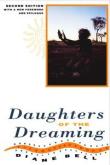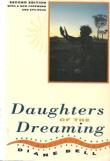AustLit
Latest Issues
AbstractHistoryArchive Description
'This new edition, which is based on research done in the 1970s, includes an epilogue in which Bell reflects on her original fieldwork from the perspective of the 1990s, examining the changes in the field and in feminist theory and practice. ' (Source: Publisher's website)
Publication Details of Only Known VersionEarliest 2 Known Versions of
Other Formats
- Also sound recording, and eBook.
Works about this Work
-
Moving through Space and (Not?) Time : North Australian Dreamtime Narratives
2015
single work
criticism
— Appears in: Narrative and Identity Construction in the Pacific Islands 2015; (p. 15–35) 'This chapter is concerned with an analysis of narrative structure in the endangered non-Pama-Nyungan language Jaminjung and Australian Kriol. Previous analyses of Aboriginal narratives and story-telling techniques focused on the significance of place in plot and content (McGregor, 2005; Klapproth, 2004; Bavin, 2004). This study aims to extend these observations to include expressions of motion as a major structuring device in narratives. Furthermore, spatial may take precedence over temporal ordering of events in narrative. I argue that spatial narrative structuring is deeply rooted in cultural and environmental features creating a connection of unique identity for every ‘owner’ and audience of a story.' (Publication summary) -
The Pleiades and the Dreamtime : An Aboriginal Women's Story and Other Ancient World Traditions
2012
single work
criticism
— Appears in: Coolabah , no. 9 2012; -
On Diane Bell's Daughters of the Dreaming
1995
single work
correspondence
— Appears in: Australian Aboriginal Studies , no. 2 1995; (p. 34-37)'Introductory comment, Editor
In 1993, Allen and Unwin published a second edition of Diane Bell's Daughters of the Dreaming. In the important Epilogue to the book, Bell comments: 'In explicating the critical perspective from which I write in 1992, I am writing reflexively of my earlier reflexivity!' (1993, 273). In undertaking this project, she makes the point (277): 'It is obvious to me now that building a case for the merits of an ethnography that begins with the experience of women entails methodological and epistemological considerations'. Her discussion of epistemological considerations is informed by standpoint theories, the attraction of which, she suggests (282), is 'that they balance the feminist intuition that women have something real to say about their lives with the anthropological injunction to transcend individual experience in our ethnographic accounts'.' (Introduction)
-
"Daughters of the Dreaming"
1994
single work
review
— Appears in: Aboriginal History , vol. 18 no. 1, 2 1994; (p. 167)
— Review of Daughters of the Dreaming 1993 single work life story -
Narratives of the Encounter at Ntaria
1994
single work
criticism
— Appears in: Oceania , December vol. 65 no. 2 1994; (p. 131-150)'In the month of July, 1876, Western Aranda resident in the area marked out by Ltalaltuma, Emalkna, Ljaba and Roulbmaulbma — the area west of Uruna now called Missionary Plain, and bordered to the north by the Western MacDonnells — may have sighted the first European settlers on their lands. It was during this time that a forward party from a Lutheran mission group set out from Dalhousie Springs, some 285 miles south, to inspect the mission lease along either side of the Finke River complex (Bowman n.d.:68-9). It was about a year later that the main party arrived via Owen Spring, the first cattle lease established in Central Australia. Initially they travelled to the area south of Jalpalpa, now known as Glen Helen. Then the Lutherans travelled south, to a point on the Finke below Ntaria waterhole. They sank a well and determined to build their community there; at the place they would call 'Hermannsburg'. ' (Introduction)
-
"Daughters of the Dreaming"
1994
single work
review
— Appears in: Aboriginal History , vol. 18 no. 1, 2 1994; (p. 167)
— Review of Daughters of the Dreaming 1993 single work life story -
Understanding Aboriginal Women
1984
single work
review
— Appears in: Hemisphere , July-August vol. 29 no. 1 1984; (p. 48)
— Review of Daughters of the Dreaming 1993 single work life story -
Autobiographical Storytelling by Australian Aboriginal Women
1992
single work
criticism
— Appears in: Decolonizing the Subject : The Politics of Gender in Women's Autobiography 1992; (p. 370-384) 'It is only very recently that the written autobiographies of Aboriginal people have begun to be published in Australia. So extreme has been the degradation and virtual erasure of Aboriginal culture that it is impossible for white readers to imagine the scale of obstacles that have to be negotiated and compromises that have to be made in order for Aboriginal people to offer their personal stories to a white reading public, and to do so in genres and modes that are not only foreign to Aboriginal culture but have been brutally efficient agents of its destruction for two hundred years. Much Aboriginal history is difficult to relate because it is literally unspeakable. For white readers there are also difficulties that go well beyond the challenges of cross-cultural comprehension. Even the most sympathetic white observers and promoters of Aboriginal culture face the now familiar risk of consolidating the old patterns of domination each time they attempt to act as interpreters of Aboriginal production. It can be argued, however, that there is a much more serious risk of perpetuating the negation of Aboriginal culture by ignoring the new work and remaining silent, and it is from this position that this essay is written. Further, Aboriginal autobiography offers much more than a window for viewing authentic "first-hand" presentations of black experience; it also contributes to a more understanding of the genres by which cultures tell their personal and communal stories and so define themselves. In other words, the window enables vision and reflection both ways, upon fundamentally different worlds and their representations.' (Author's introduction, 370-371)
-
The Pleiades and the Dreamtime : An Aboriginal Women's Story and Other Ancient World Traditions
2012
single work
criticism
— Appears in: Coolabah , no. 9 2012; -
Moving through Space and (Not?) Time : North Australian Dreamtime Narratives
2015
single work
criticism
— Appears in: Narrative and Identity Construction in the Pacific Islands 2015; (p. 15–35) 'This chapter is concerned with an analysis of narrative structure in the endangered non-Pama-Nyungan language Jaminjung and Australian Kriol. Previous analyses of Aboriginal narratives and story-telling techniques focused on the significance of place in plot and content (McGregor, 2005; Klapproth, 2004; Bavin, 2004). This study aims to extend these observations to include expressions of motion as a major structuring device in narratives. Furthermore, spatial may take precedence over temporal ordering of events in narrative. I argue that spatial narrative structuring is deeply rooted in cultural and environmental features creating a connection of unique identity for every ‘owner’ and audience of a story.' (Publication summary) -
[Review Essay] Daughters of the Dreaming
1986
single work
essay
— Appears in: Australian Aboriginal Studies , no. 2 1986; (p. 80-82)'This book is one of the growing number of anthropological works on women by women. When Bell writes in one of her opening passages that she locates her "analysis within the framework of feminist thought", one may be forgiven for fearing that one is about to encounter the curious astigmatism by which radical feminism manages to misproportion every social reality...' (Introduction)
-
Social Anthropology : Daughters of the Dreaming
1994
single work
essay
— Appears in: Australian Aboriginal Studies , no. 1 1994; (p. 45-49)'Daughters of the Dreaming was originally published in 1983, after being modified from the author's doctoral thesis (Australian National University). It is an analysis of data collected in Central Australia, primarily at Ali Curung (Alekerenge), an Aboriginal settlement to the south of Tennant Creek, originally known as Warrabri. Bell conducted research there at various times between 1976 and 1982, mostly between September 1976 and January 1978.' (Introduction)
- Aboriginal culture
- Aboriginal Dreamtime
- Aboriginality
- Feminism
- Aboriginal women
- Aboriginal ceremonies
- Indigenous knowledge
- Aboriginal Warlpiri people
- Aboriginal Warumungu people
- Aboriginal Kaytetye people
- Aboriginal relationship with the land
- Dreaming tracks
- Aboriginal religion & stories
- Aboriginal secret & sacred sites
- Customs (social)
- Northern Territory,
- Arnhem Land, Top End, Northern Territory,





